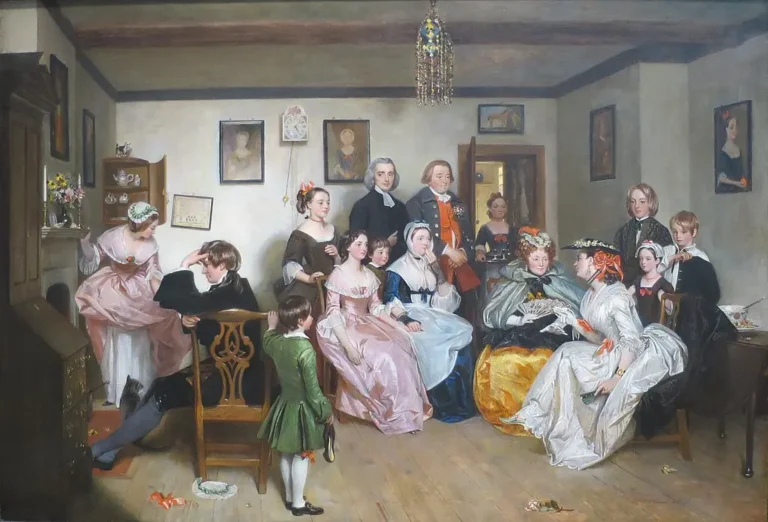Characters are a finished product. Characterization is the technique of production of the characters, it reflects the way of thinking.
Goldsmith was not only a novelist but also a playwright: he wrote “The Good Natur’d Man” (1768) and “She Stoops to Conquer” (1773). When he wrote “The Vicar of Wakefield”, Goldsmith was testing through fiction characters who were to become perfectible on stage. Full-fledged characters are fleshed-out characters. Fiction writing was for him a draft for theatre, that’s the reason why there are so many references to theatre in the text.
“All the same flesh and blood” (p. 10)
All of the characters are connected through the family.
The family circle
Being a vicar, Primrose reminds his reader that all mankind makes up a large family. Characters are defined through kinship (family relationships). For instance, the Primroses form the typical family structure of the 18th century:
- the father is at the centre (patriarchal model)
- the eldest son is favoured (primogeniture)
- gender roles are well-differentiated (p. 45)
The patronym is Primrose: it is a forerunner of the end of the story. To be “prim” is to behave well and to be easily shocked. The “rose” is a flower, the symbol of England. “Rose” is also the preterit from “to rise”, indicating social elevation.
Throughout the novel, the reader comes across characters who are connected by family ties. Yet, in the denouement, the already existing family bonds are strengthened: In the end, the Primrose family find themselves united to the Wilmots (through George’s wedding) and to the Thornhills (through Sophia’s wedding, and through Olivia’s wedding that proves to have been genuine after all).
Matrimony
Chasing husbands is the chief preoccupation of Deborah (Mrs Primrose), and, to a lesser extent, Olivia. Marrying is shown to be a financial transaction: Mr Wilmot is said to be ‘in circumstances to give [Arabella] a large fortune’ (14) and, conversely, Mr Primrose ‘could make a very handsome settlement on [his] son’ (14) When it is revealed that Primrose has lost all his savings and riches the wedding cannot go ahead.
In the novel, Squire Thornhill cynically flouts (insults) the rules of matrimony and the family institution, which is the foundation stone of society. Having abused Olivia, Thornhill offers to marry her to another man, while remaining her lover. This is a typical instance of the double standard, which only men could indulge in, in the 18th century: ‘We can marry her to another in a short time, and what is more, she may keep her lover beside; for I protest I shall ever continue to have a true regard for her’ (134)
Justice will be done, Thornhill the villain will be punished for his misdemeanours, yet there is no harsh retribution at the novel’s end. Thornhill is more mocked at and held as an object of ridicule than made to atone for his guilt through pain and suffering. The former philanderer (woman chaser) is shown ‘learning to play the French horn’ (189) This denouement is perfectly in line with comedy.
The characterization process
Apart from the narrator, who, as first-person narrator, may indulge in a form of introspection whenever he reflects on the meaning of Providence, and destiny, most characters are deprived/devoid of substance. They have no real depth.
The narrator may be more interested in presenting types than in probing any complex psychology. For example, he uses comparisons with well-known mythological or biblical figures:
- Olivia is Hebe (11): a goddess of sweet youth who was also one of Aphrodite’s attendants (a member of Aphrodite’s retinue).
- Moses immediately calls to mind his biblical namesake: the forsaken baby floating on the Nile. In “The Vicar of Wakefield”, Moses is launched into the world of crooks (rogues and swindlers) and left to fend for himself. He is eventually imposed upon/gulled by Ephraim Jenkinson (a professional sharper: the grocer of green paltry spectacles)
- Burchell is not unlike a fairy tale personage: ‘He was fondest of the company of children…and seldom went out without something in his pockets for them, a piece of gingerbread, or a half-penny whistle’. Burchell may be reminiscent of the piper of Hamelin, in German folklore.
Characters are introduced through a form of choreography. The motif of the dance may be useful to define the way in which characters are brought into the fiction.
Most of them form pairs and come in sets of two:
- Two vicars: Primrose/Wilmot;
- Two daughters with Italian, romantic names: Sophia/Olivia;
- Two little sons with monosyllabic names that are phonetically close: Dick and Bill;
- Two ladies of the town: Lady Blarney and Miss Carolina Wilhelmina Amelia Skeggs and so on…
Sometimes a character is hidden behind another: hence the topic of the mask:
- Burchell conceals Sir William Thornhill, the baronet.
- Wilkinson, the butler, passes himself off as Mr Arnold, his master (100)
- Ephraim Jenkinson is the typical example of the character who assumes various identities. He keeps dressing up to play many parts.
All the world’s a stage
Theatricality is central to “The Vicar of Wakefield” and contributes largely to shape characters. The theater metaphor is pervasive.
Acting is part of life: making up; dressing up to the nines, are indispensable to trap husbands. The vicar insists humorously on Deborah’s effort to look her best and to show her daughters to their advantage; ‘day of finery’ (25)
Comedy stems from the gap between the effect that is sought after and the lamentable result in real life, thus when the Primrose women are forced to walk to church, in their Sunday best, the disastrous episode is full of comical overtones.
Comedy also results from a difference between appearance and essence: the two “ladies” of town are dressed up as duchesses, but, for all their finery, swear like troopers! “by the living jingo she was all amuck of sweat” (you should remember that in English horses sweat; men perspire; and women glow!)
“The Vicar of Wakefield” stages a big game of “Blind man’s buff”, a play of mistaken identities (Who’s who?). Who are the goodies, who are the villains? For a time Deborah rejects Burchell (Sir William), until she realizes her error. Deborah is hoodwinked by flashy appearances.
Similarly, Ephraim Jenkinson, who is first described as the greatest rascal that ever was, proves instrumental in saving the Primroses from prison, by exhibiting proofs of Squire Thornhill’s duplicity (179)
Finally, theatrical representation is used as a device/ a ploy in the plot. It is when Primrose sees a new actor playing Horatio in “Hamlet” that the vicar recognizes his son Georges (101). Simultaneously, on seeing his father and Miss Wilmot sitting in the audience, George is suddenly overwhelmed with emotion to such an extent that he feels unequal to dissembling, to counterfeiting. He cannot bring himself to play his part in Shakespeare’s tragedy.
What “The Vicar of Wakefield” shows are interchanges between the world of the Theatre and of the World reality, indeed more often than not, the boundaries between the two turn out to be blurred.

